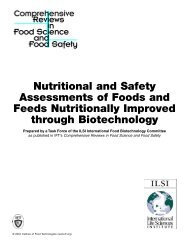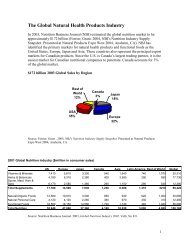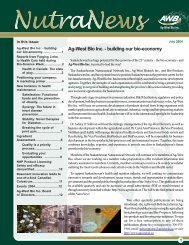Beyond Borders: Global biotechnology report 2010
Beyond Borders: Global biotechnology report 2010
Beyond Borders: Global biotechnology report 2010
Create successful ePaper yourself
Turn your PDF publications into a flip-book with our unique Google optimized e-Paper software.
Mature, profitable companies were a big<br />
part of this story, with Amgen closing a<br />
US$2 billion debt transaction in the first<br />
quarter and others following suit later in the<br />
year — including Talecris Biotherapeutics<br />
(which raised US$600 million), Cephalon<br />
(US$500 million) and Bio-Rad Laboratories<br />
(US$300 million). Companies with exciting<br />
late-stage clinical news also tapped the equity<br />
and debt markets to raise significant sums<br />
— these included Vertex Pharmaceuticals<br />
(US$940 million), Human Genome Sciences<br />
(US$851 million), Dendreon (US$601<br />
million) and Incyte (US$540 million).<br />
Vertex has always had a knack for raising<br />
money opportunistically and at times<br />
creatively, including through the sale of<br />
future royalty streams, and this trend<br />
continued in 2009. Included in the total<br />
above was approximately US$120 million<br />
raised through notes secured by certain<br />
future milestones payments under the<br />
company’s collaboration with Janssen<br />
related to telaprevir in Europe. The company<br />
raised an additional US$35 million through<br />
the sale of other milestones in the Janssen<br />
agreement and received US$105 million<br />
through the modification of an existing<br />
collaboration with Mitsubishi Tanabe,<br />
bringing Vertex’s total fund-raising in 2009<br />
to more than US$1.1 billion.<br />
Companies with earlier-stage technologies<br />
or those still waiting for their first clinical<br />
breakthrough continued, when possible,<br />
to take advantage of market conditions<br />
to secure funds utilizing a variety of<br />
transactions, including follow-on public<br />
offerings, PIPEs, committed equity<br />
financing facilities and debt transactions,<br />
as well as corporate alliances. What<br />
remains sobering, however, is the amount<br />
of money required to become a selfsustaining<br />
biotech company. In prior<br />
editions of <strong>Beyond</strong> borders, we noted that<br />
the journey from start-up to sustainability<br />
takes US$1 billion to US$2 billion. It is<br />
noteworthy that two of the fund-raising<br />
stars of 2009, Vertex and HGS, have each<br />
raised in excess of US$3 billion and have<br />
not yet launched the products that they<br />
hope will get them to sustainability. While<br />
a fortunate few are sure to emerge every<br />
year, the average company must think<br />
creatively about its business and financing<br />
model to bridge difficult funding periods.<br />
Quarterly breakdown of Americas <strong>biotechnology</strong> financings, 2009 (US$m)<br />
Source: Ernst & Young, BioCentury, BioWorld, Windhover and VentureSource<br />
Figures in parentheses are number of financings. Numbers may appear inconsistent because of rounding.<br />
The US IPO drought came to an end<br />
in August 2009 with the Cumberland<br />
Pharmaceuticals transaction. Cumberland,<br />
which raised US$79 million, is a specialty<br />
pharma company that acquires late-stage<br />
development assets or approved products<br />
which it markets to targeted physician<br />
populations. The company was founded in<br />
1999 and has been profitable for the last<br />
six years. Remarkably, the company raised<br />
only US$14 million of equity capital prior<br />
to its IPO — in other words, not a typical<br />
performance for a biotech IPO candidate,<br />
but a welcome development nonetheless.<br />
The Talecris Biotherapeutics IPO, which<br />
closed in early October, was even more<br />
atypical. The company issued US$550<br />
million of common stock, and Talecris’<br />
private equity backers sold shares worth<br />
an additional US$400 million. (For more<br />
discussion, refer to “Anatomy of a private<br />
equity IPO” on the next page.) Talecris,<br />
which markets plasma-derived protein<br />
therapeutics and operates a network of<br />
plasma collection centers, spun out of Bayer<br />
Corporation in 2005 and is the successor<br />
to entities that trace their history back to<br />
Cutter Laboratories, founded in the 1940s.<br />
First quarter 2009 Second quarter 2009 Third quarter 2009 Fourth quarter 2009 Total<br />
US Canada US Canada US Canada US Canada US Canada<br />
IPO $0 $0 $0 $0 $629 $0 $68 $0 $697 $0<br />
(0) (0) (0) (0) (2) (0) (1) (0) (3) (0)<br />
Follow-on $538 $0 $698 $77 $1,800 $37 $2,129 $24 $5,165 $138<br />
(5) (0) (8) (4) (22) (4) (19) (2) (54) (10)<br />
Venture $1,152 $24 $992 $31 $1,079 $26 $1,333 $19 $4,556 $100<br />
(96) (6) (71) (10) (99) (11) (86) (9) (352) (36)<br />
Other $2,797 $35 $2,102 $402 $1,621 $30 $1,096 $29 $7,617 $495<br />
(49) (5) (90) (11) (91) (7) (63) (5) (293) (28)<br />
Total $4,488 $58 $3,792 $510 $5,129 $93 $4,626 $71 $18,034 $733<br />
(150) (11) (169) (25) (214) (22) (169) (16) (702) (74)<br />
67








